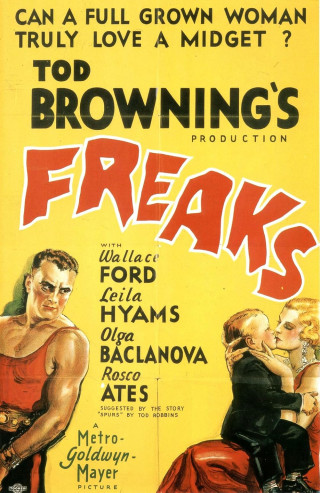By the time he came to Freaks, Browning was renowned as the director of Universal Pictures’ 1931 movie Dracula, starring Bela Lugosi. Browning had also served as Dracula’s co-producer, pairing with Carl Laemmle Jr, son of Universal’s founder. Following Dracula, Laemmle produced Frankenstein, another Universal release and one of the most fundamental movies in modern Gothic horror. MGM Studios’ Irving Thalberg hired Browning in an effort to compete with Universal’s growing suite of popular monster movies.
In addition to the studio mandate to crush the competition, Browning had an additional motivation to focus his film on sideshow. According to film scholar Hugh S. Manon, “it is difficult to ignore the obvious biographical connection between [Browning’s] film and his youthful experience as a magician’s assistant and showman in the American carnival sideshow circuit.”
For many audience members in the 1930s, “sideshow” was shorthand for a frightening sort of otherness. The non-normative body invited judgment, gawking, fascination, and horror all at once, and it powered a sizeable, lucrative economy of display.
Circus scholar Aine Norris notes concepts of “freakery” were
part of a larger conversation happening at the turn of the century regarding what it meant for a body to be pure or worthy of life. The eugenics movement raged in America and abroad, and bodies deemed as ‘freaks’ could be subject to investigation, sterilization, or institutionalization.
With this in mind, Browning deliberately worked to humanize the actors. Rather than enlist career film actors, he cast a number of then-active performers to appear as themselves, including conjoined twins Daisy and Violet Hilton, Prince Randian the Living Torso, Jonny Eck the Half-Boy, Koo Koo the Bird Girl, and Schlitzie the “pinhead.” The performers are shown living their lives on the circus backlot, having relationships, building families, and participating in the performance life and ecosystem of the circus.
Audiences were asked to consider that the display of human difference was dehumanizing or even exploitative but also to understand that the sideshow represented a locus of community and a way for disabled performers to make an independent living. The film’s arc demonstrates that, even though mainstream society would consider them unusual if not grotesque, the tight-knit sideshow community showed a clear contrast between perception and reality, assumption and skill, “their monstrous physical appearance and their morally superior characters,” write Brottman and Brottman.
